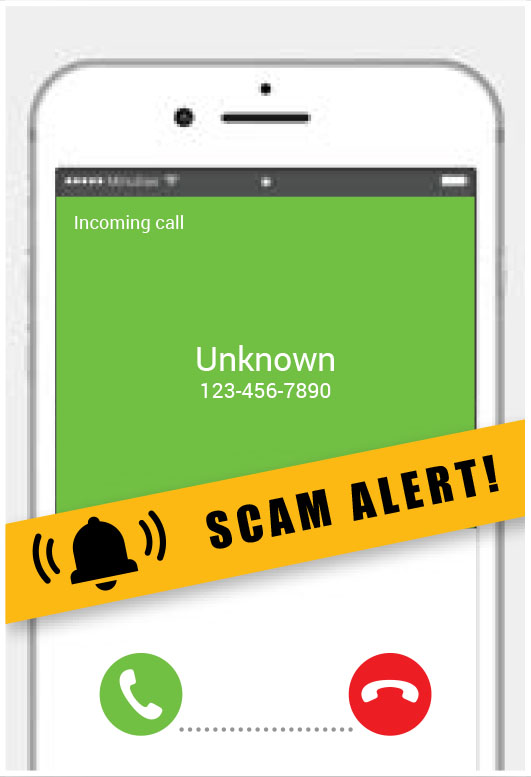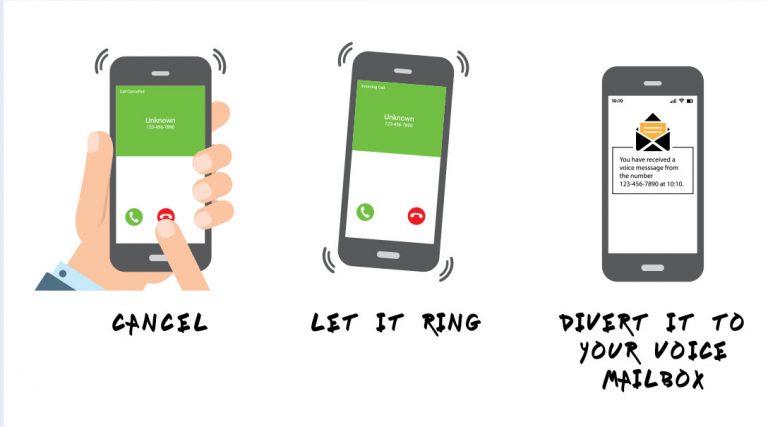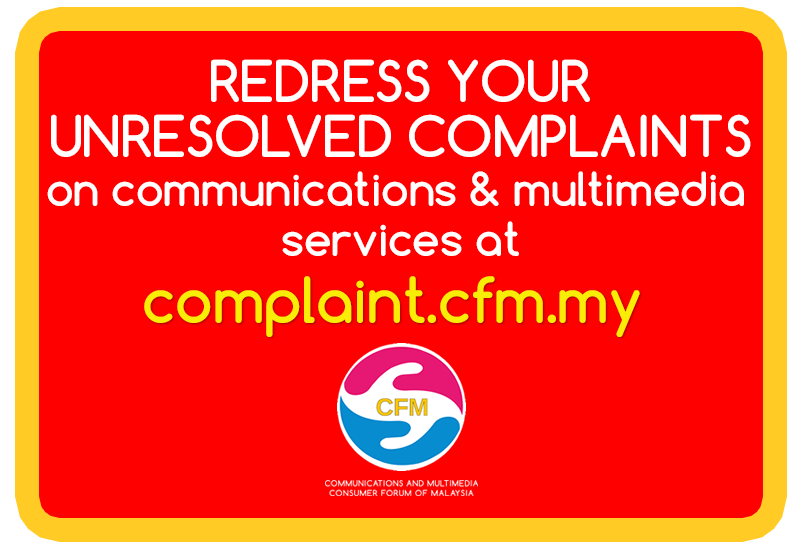
As our lives are becoming more dependent on our smartphones, it is only natural that crooks and thieves now use this platform for their nefarious deeds to try and part us with our hard earned money. We now live at a time where we can no longer just ignore calls from people we don’t actually know and hope that will be the end of it. In recent months, there has been a noticeable increase in the number of grouses and complaints from mobile consumers about the spam and scam calls that they have been receiving. It would seem that there has been a sudden surge in unsolicited calls to our mobile numbers from people trying to sell us something to those pretending to be from banks or the authorities asking us to take action on a serious legal matter. Instead of becoming lambs to the slaughter, we should take the initiative and protect ourselves from these “digital villains” and SHOUT! would like to show you how to do this.
By: Ahmad Izham Khairuddin
*—————————————-*
| WHAT TO LOOK OUT FOR! |
| It is sometimes difficult to distinguish between genuine and scam calls. However, if the caller tells you any of the following, you have every right to be suspicious. • Request for your personal data (such as your identity card number or your credit card number) to verify your identity. • Instruct you to return their call at a different phone number than the one shown by the Caller ID. • Claim you have won a prize, contest, or other items of value but need you to provide details of your bank account or make some payment to facilitate the claims process. • Claims that you have unpaid fees or fine that you need to pay on the same day to avoid legal action. • Request to verify a PIN code sent to your phone without you having personally initiated an update to an account, service, or profile. |
| WHAT TO DO IF YOU RECEIVE A SUSPICIOUS CALL! |
| It is sometimes difficult to distinguish between genuine and scam calls. However, do take note of the following clues: • Never reveal any personal details or details of any of your accounts to the other person even if it is to verify your identity. Instead, inform the caller that you will call back with the details, making sure that you call a phone number that has been verified as legitimate, either through the official website of your service provider or from a contract or bill that you have with you. • Avoid saying the word “yes” when asked a question but instead answer using a full sentence as most of these calls are recorded and they might use the recording as proof of your agreement to a subscription or purchase. • Make sure you record the phone conversation using your smartphone in case you need it as proof for any related disputes. Your smartphone should be able to do this in the settings or you can also install some apps for this purpose. • Request for their name and designation, including their full organisation name. • Request for full details of the reason why they are calling you; if it is for an outstanding debt, ask for the contract number, when it was signed, what was the total amount, what was the address listed on the contract, etc. • If you are confident that it was a scam call, lodge a police report and provide the telephone recording any notes that you have taken to facilitate the police in their investigations. • The most important thing is to resist being pressured to provide any of your personal details or related information, even when harassed to do so. Stand firm with your stand of calling back with the necessary information. • Stay informed of the latest scams by paying attention to public service announcements or those by your service providers. |
| THIS IS WHAT YOU SHOULD DO FROM NOW ON! |
|
1. The simplest way to deal with unwanted or scam calls is to NOT answer them. This should be easy since the caller ID function on your mobile phone usually indicates who is calling you and from there you are able to see if it is a recognizable number or not. By not answering numbers that do not belong to your internal phonebook list, you have solved part of the problem. However, to make this work for important calls that you might receive, you have to make sure that important numbers are stored in your internal phonebook list. These numbers may include the numbers to all your service providers (telcos, banks, utility companies, yours and spouse office numbers, children’s school numbers, etc.). 2. Truth be told, scammers still might find a way around this and it is usually either one of two. The first one is that they use the call spoofing method whereby they manipulate their caller ID to match that of a service provider in your phonebook list. Since you already have that number stored, you will normally think that it is safe to answer the call. In this case, please refer back to the section about identifying scam calls mentioned earlier. If you fiddle with your phone settings long enough, you might even find an option to let only calls from your phonebook list to go through while the rest either gets rejected or forwarded to your voicemail. 3. The other way that scammers can still try to get to you is by leaving a voice message that sounds important enough for you to return their call. Then again, refer to the identifying scam calls section to gauge whether you are dealing with one or not. In this instance, when calling back, there are a few things that you can do to verify the authenticity of the person you are calling. 4. Always do a reverse search of the number that they are asking you to call back. The easiest way to do this is by putting the number through Google Search or you can go directly to SEARCH YELLOW DIRECTORY or FINDWHOCALLSME or even WHOCALLSME and key in the suspicious number. These online websites would have 5. As mentioned earlier, you can also rely on mobile apps such as Truecaller. Nomorombo or numerous other apps to help you identify who is calling you and also to block numbers that keep calling you. Some apps also help identify scam calls via crowdsourced data. Do your research and install the right app for your needs. 6. While not giving away your mobile number to any Tom, Dick, and Harry is still the best option, you still want to get the freebies and the discounts but not at all comfortable at giving away your personal mobile number for fear of getting harassed. Well, there are a few ways for you to still get those freebies and discounts by using alternative numbers. One free option is to register for Google Voice and get a local US number for free although registering for one is a bit tricky but not impossible. Having a local US number might also discourage telemarketing and spam callers from harassing you. Even if they did, you can safely let those calls be forwarded to the voicemail. 7. Other ways to get an alternative number is through Skype and other similar apps like Burner, Hushed or Too but these are paid services. The easiest way to get an alternative number is to subscribe to a postpaid service with a local service provider and there are some that offer plans at less than RM10 per month. Having an alternative number allows you to use this number for any requirements with regards to contests, discounts, online forms and subscriptions, or another similar usage. So, if you receive any calls to this other number, you can be sure that it is from someone or some organisation that you have given it freely to and can safely ignore if you so do wish. |
| IF ALL ELSE FAILS! |
| If you find yourself having to answer one unwanted call too many, you might want to consider changing your number completely, and this time, guard this new number as a very private and close secret. That free powerbank offer in exchange for your phone number might not be worth it after all. |
Source : SHOUT Q4, 2017

As our lives are becoming more dependent on our smartphones, it is only natural that crooks and thieves now use this platform for their nefarious deeds to try and part us with our hard earned money. We now live at a time where we can no longer just ignore calls from people we don’t actually know and hope that will be the end of it. In recent months, there has been a noticeable increase in the number of grouses and complaints from mobile consumers about the spam and scam calls that they have been receiving. It would seem that there has been a sudden surge in unsolicited calls to our mobile numbers from people trying to sell us something to those pretending to be from banks or the authorities asking us to take action on a serious legal matter. Instead of becoming lambs to the slaughter, we should take the initiative and protect ourselves from these “digital villains” and SHOUT! would like to show you how to do this.
By: Ahmad Izham Khairuddin
*—————————————-*
| WHAT TO LOOK OUT FOR! |
| It is sometimes difficult to distinguish between genuine and scam calls. However, if the caller tells you any of the following, you have every right to be suspicious. • Request for your personal data (such as your identity card number or your credit card number) to verify your identity. • Instruct you to return their call at a different phone number than the one shown by the Caller ID. • Claim you have won a prize, contest, or other items of value but need you to provide details of your bank account or make some payment to facilitate the claims process. • Claims that you have unpaid fees or fine that you need to pay on the same day to avoid legal action. • Request to verify a PIN code sent to your phone without you having personally initiated an update to an account, service, or profile. |
| WHAT TO DO IF YOU RECEIVE A SUSPICIOUS CALL! |
| It is sometimes difficult to distinguish between genuine and scam calls. However, do take note of the following clues: • Never reveal any personal details or details of any of your accounts to the other person even if it is to verify your identity. Instead, inform the caller that you will call back with the details, making sure that you call a phone number that has been verified as legitimate, either through the official website of your service provider or from a contract or bill that you have with you. • Avoid saying the word “yes” when asked a question but instead answer using a full sentence as most of these calls are recorded and they might use the recording as proof of your agreement to a subscription or purchase. • Make sure you record the phone conversation using your smartphone in case you need it as proof for any related disputes. Your smartphone should be able to do this in the settings or you can also install some apps for this purpose. • Request for their name and designation, including their full organisation name. • Request for full details of the reason why they are calling you; if it is for an outstanding debt, ask for the contract number, when it was signed, what was the total amount, what was the address listed on the contract, etc. • If you are confident that it was a scam call, lodge a police report and provide the telephone recording any notes that you have taken to facilitate the police in their investigations. • The most important thing is to resist being pressured to provide any of your personal details or related information, even when harassed to do so. Stand firm with your stand of calling back with the necessary information. • Stay informed of the latest scams by paying attention to public service announcements or those by your service providers. |
| THIS IS WHAT YOU SHOULD DO FROM NOW ON! |
|
1. The simplest way to deal with unwanted or scam calls is to NOT answer them. This should be easy since the caller ID function on your mobile phone usually indicates who is calling you and from there you are able to see if it is a recognizable number or not. By not answering numbers that do not belong to your internal phonebook list, you have solved part of the problem. However, to make this work for important calls that you might receive, you have to make sure that important numbers are stored in your internal phonebook list. These numbers may include the numbers to all your service providers (telcos, banks, utility companies, yours and spouse office numbers, children’s school numbers, etc.). 2. Truth be told, scammers still might find a way around this and it is usually either one of two. The first one is that they use the call spoofing method whereby they manipulate their caller ID to match that of a service provider in your phonebook list. Since you already have that number stored, you will normally think that it is safe to answer the call. In this case, please refer back to the section about identifying scam calls mentioned earlier. If you fiddle with your phone settings long enough, you might even find an option to let only calls from your phonebook list to go through while the rest either gets rejected or forwarded to your voicemail. 3. The other way that scammers can still try to get to you is by leaving a voice message that sounds important enough for you to return their call. Then again, refer to the identifying scam calls section to gauge whether you are dealing with one or not. In this instance, when calling back, there are a few things that you can do to verify the authenticity of the person you are calling. 4. Always do a reverse search of the number that they are asking you to call back. The easiest way to do this is by putting the number through Google Search or you can go directly to SEARCH YELLOW DIRECTORY or FINDWHOCALLSME or even WHOCALLSME and key in the suspicious number. These online websites would have 5. As mentioned earlier, you can also rely on mobile apps such as Truecaller. Nomorombo or numerous other apps to help you identify who is calling you and also to block numbers that keep calling you. Some apps also help identify scam calls via crowdsourced data. Do your research and install the right app for your needs. 6. While not giving away your mobile number to any Tom, Dick, and Harry is still the best option, you still want to get the freebies and the discounts but not at all comfortable at giving away your personal mobile number for fear of getting harassed. Well, there are a few ways for you to still get those freebies and discounts by using alternative numbers. One free option is to register for Google Voice and get a local US number for free although registering for one is a bit tricky but not impossible. Having a local US number might also discourage telemarketing and spam callers from harassing you. Even if they did, you can safely let those calls be forwarded to the voicemail. 7. Other ways to get an alternative number is through Skype and other similar apps like Burner, Hushed or Too but these are paid services. The easiest way to get an alternative number is to subscribe to a postpaid service with a local service provider and there are some that offer plans at less than RM10 per month. Having an alternative number allows you to use this number for any requirements with regards to contests, discounts, online forms and subscriptions, or another similar usage. So, if you receive any calls to this other number, you can be sure that it is from someone or some organisation that you have given it freely to and can safely ignore if you so do wish. |
| IF ALL ELSE FAILS! |
| If you find yourself having to answer one unwanted call too many, you might want to consider changing your number completely, and this time, guard this new number as a very private and close secret. That free powerbank offer in exchange for your phone number might not be worth it after all. |
Source : SHOUT Q4, 2017

As our lives are becoming more dependent on our smartphones, it is only natural that crooks and thieves now use this platform for their nefarious deeds to try and part us with our hard earned money. We now live at a time where we can no longer just ignore calls from people we don’t actually know and hope that will be the end of it. In recent months, there has been a noticeable increase in the number of grouses and complaints from mobile consumers about the spam and scam calls that they have been receiving. It would seem that there has been a sudden surge in unsolicited calls to our mobile numbers from people trying to sell us something to those pretending to be from banks or the authorities asking us to take action on a serious legal matter. Instead of becoming lambs to the slaughter, we should take the initiative and protect ourselves from these “digital villains” and SHOUT! would like to show you how to do this.
By: Ahmad Izham Khairuddin
*—————————————-*
| WHAT TO LOOK OUT FOR! |
| It is sometimes difficult to distinguish between genuine and scam calls. However, if the caller tells you any of the following, you have every right to be suspicious. • Request for your personal data (such as your identity card number or your credit card number) to verify your identity. • Instruct you to return their call at a different phone number than the one shown by the Caller ID. • Claim you have won a prize, contest, or other items of value but need you to provide details of your bank account or make some payment to facilitate the claims process. • Claims that you have unpaid fees or fine that you need to pay on the same day to avoid legal action. • Request to verify a PIN code sent to your phone without you having personally initiated an update to an account, service, or profile. |
| WHAT TO DO IF YOU RECEIVE A SUSPICIOUS CALL! |
| It is sometimes difficult to distinguish between genuine and scam calls. However, do take note of the following clues: • Never reveal any personal details or details of any of your accounts to the other person even if it is to verify your identity. Instead, inform the caller that you will call back with the details, making sure that you call a phone number that has been verified as legitimate, either through the official website of your service provider or from a contract or bill that you have with you. • Avoid saying the word “yes” when asked a question but instead answer using a full sentence as most of these calls are recorded and they might use the recording as proof of your agreement to a subscription or purchase. • Make sure you record the phone conversation using your smartphone in case you need it as proof for any related disputes. Your smartphone should be able to do this in the settings or you can also install some apps for this purpose. • Request for their name and designation, including their full organisation name. • Request for full details of the reason why they are calling you; if it is for an outstanding debt, ask for the contract number, when it was signed, what was the total amount, what was the address listed on the contract, etc. • If you are confident that it was a scam call, lodge a police report and provide the telephone recording any notes that you have taken to facilitate the police in their investigations. • The most important thing is to resist being pressured to provide any of your personal details or related information, even when harassed to do so. Stand firm with your stand of calling back with the necessary information. • Stay informed of the latest scams by paying attention to public service announcements or those by your service providers. |
| THIS IS WHAT YOU SHOULD DO FROM NOW ON! |
|
1. The simplest way to deal with unwanted or scam calls is to NOT answer them. This should be easy since the caller ID function on your mobile phone usually indicates who is calling you and from there you are able to see if it is a recognizable number or not. By not answering numbers that do not belong to your internal phonebook list, you have solved part of the problem. However, to make this work for important calls that you might receive, you have to make sure that important numbers are stored in your internal phonebook list. These numbers may include the numbers to all your service providers (telcos, banks, utility companies, yours and spouse office numbers, children’s school numbers, etc.). 2. Truth be told, scammers still might find a way around this and it is usually either one of two. The first one is that they use the call spoofing method whereby they manipulate their caller ID to match that of a service provider in your phonebook list. Since you already have that number stored, you will normally think that it is safe to answer the call. In this case, please refer back to the section about identifying scam calls mentioned earlier. If you fiddle with your phone settings long enough, you might even find an option to let only calls from your phonebook list to go through while the rest either gets rejected or forwarded to your voicemail. 3. The other way that scammers can still try to get to you is by leaving a voice message that sounds important enough for you to return their call. Then again, refer to the identifying scam calls section to gauge whether you are dealing with one or not. In this instance, when calling back, there are a few things that you can do to verify the authenticity of the person you are calling. 4. Always do a reverse search of the number that they are asking you to call back. The easiest way to do this is by putting the number through Google Search or you can go directly to SEARCH YELLOW DIRECTORY or FINDWHOCALLSME or even WHOCALLSME and key in the suspicious number. These online websites would have 5. As mentioned earlier, you can also rely on mobile apps such as Truecaller. Nomorombo or numerous other apps to help you identify who is calling you and also to block numbers that keep calling you. Some apps also help identify scam calls via crowdsourced data. Do your research and install the right app for your needs. 6. While not giving away your mobile number to any Tom, Dick, and Harry is still the best option, you still want to get the freebies and the discounts but not at all comfortable at giving away your personal mobile number for fear of getting harassed. Well, there are a few ways for you to still get those freebies and discounts by using alternative numbers. One free option is to register for Google Voice and get a local US number for free although registering for one is a bit tricky but not impossible. Having a local US number might also discourage telemarketing and spam callers from harassing you. Even if they did, you can safely let those calls be forwarded to the voicemail. 7. Other ways to get an alternative number is through Skype and other similar apps like Burner, Hushed or Too but these are paid services. The easiest way to get an alternative number is to subscribe to a postpaid service with a local service provider and there are some that offer plans at less than RM10 per month. Having an alternative number allows you to use this number for any requirements with regards to contests, discounts, online forms and subscriptions, or another similar usage. So, if you receive any calls to this other number, you can be sure that it is from someone or some organisation that you have given it freely to and can safely ignore if you so do wish. |
| IF ALL ELSE FAILS! |
| If you find yourself having to answer one unwanted call too many, you might want to consider changing your number completely, and this time, guard this new number as a very private and close secret. That free powerbank offer in exchange for your phone number might not be worth it after all. |
Source : SHOUT Q4, 2017















